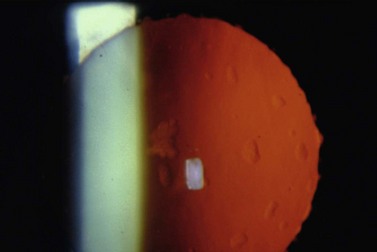CHAPTER 6 Clinical features, diagnosis and differential diagnosis
Incidence
Cataract is a common disease affecting more than 20 million people worldwide and a common cause of blindness. The prevalence increases with age. In the Beaver Dam Study, the relationship between age and incidence of cataracts was quadratic for nuclear cataract, cubic for cortical cataract, and linear for posterior subcapsular cataract (PSC)1. There are ethnic differences in the incidence of the types of cataract, with cortical cataract more common amongst those of African ancestry compared to those of European ancestry whilst nuclear and PSC are comparatively less common2.
Cataract types
There are three main types of cataract in the adult:
They may occur singly or in combination in a quarter of cases.
Cortical cataract
The cortical cataract is also called spoke cataract. These are wedge shaped opacities in both retroillumination and oblique illumination. They are triangular in shape with the apex pointing centrally. They are most commonly found in the inferonasal, then in the inferotemporal quadrant. Some have postulated that they are therefore the result of the greater exposure to sunlight, whilst twin studies have suggested that cortical cataract involves the action of dominant genes3. Their shape is due to the arrangement of the lens fibers inserting into the lens sutures. Cortical cataracts tend to start peripherally and therefore in the early stages are hidden by the iris and have little effect on vision. They are often associated with waterclefts4. These have been shown by scanning electron microscopy to be due to a separation along the suture line with globular components within it. The lens suture is not in itself a structure, but rather a zone of discontinuity within the lens where the tips of the expanded ends of the lens fibers meet. The watercleft therefore is best seen on retroillumination, and can be seen only with difficulty in oblique illumination. On slit illumination, they appear as optically empty spaces. As their refractive index is different from the surrounding fibers, they also cause confusing reflexes during retinoscopy.
Nuclear cataract
Nuclear cataract involves the lens nucleus only. It first presents as increased back scattering best seen on slit illumination. In some case, the nucleus appears very white, also called nuclear white scatter or opalescence. In many cases, the nucleus darkens and becomes brown; this is called nuclear brunescence. The increase in scattering is due to a series of non-enzymatic post-translational modifications of lens proteins. There is unfolding of the lens crystallins with formation of disulfide-linked aggregate formation. These scatter light leading to white nuclear scatter. The brown pigment is thought to be partly due to 3-hydroxy kynurenine. Scheimpflug-measured lens backscatter, an indirect measure of nuclear density, correlates with phacoemulsification time and energy. There is an exponential relationship between machine-measured effective phacoemulsification time and the degree of nuclear catatact (r2 = 0.48) and nuclear opalescence (r2 = 0.40)5.
Nuclear cataract is common after vitrectomy especially in the over-50-year-olds. It is thought to be the result of increased exposure to oxygen as the oxygen tension in the vitreous cavity next to the lens increases eight fold after vitrectomy6. It is of interest that use of multivitamins might have a protective effect in nuclear cataract but not other types7. There is an inverse association between high dietary lutein and zeaxanthine intake and prevalence of nuclear cataract8.
Nuclear cataracts have been shown to be commonly associated with retrodots (Fig 6.1).
Posterior subcapsular cataract
These are the least common of the cataracts. They are seen most readily by retroillumination. They are usually roughly circular lying in the posterior subcapsular zone. The anterior clear zone (ACZ) is reduced or absent. This zone is best seen in slit illumination and at maximum magnification and illumination. It is a thin clear zone of fibers measuring approximately 125 microns lying just beneath the anterior capsule (Fig. 6.2A,B.) With advancing posterior subcapsular cataract, the ACZ thins and eventually disappears (Fig. 6.3A,B). In diabetics, the ACZ can be larger than normal. Histological studies have shown that there is an equatorial lens bow where new fibers are being produced. In posterior subcapsular cataract (PSC), the normal lens bow is disturbed. Instead of clear fibers, aberrant lens material is produced and migrates to the posterior subcapsular region. In radiation cataract, from total body radiation for example, opacities can be seen streaming from the periphery to the posterior pole. This results in a PSC. The posterior subcapsular cataract may be associated with an anterior capsular component. However, this is not often seen clinically, but aberrant fibers can be identified in the anterior subcapsular region on histological section.
Stay updated, free articles. Join our Telegram channel

Full access? Get Clinical Tree



